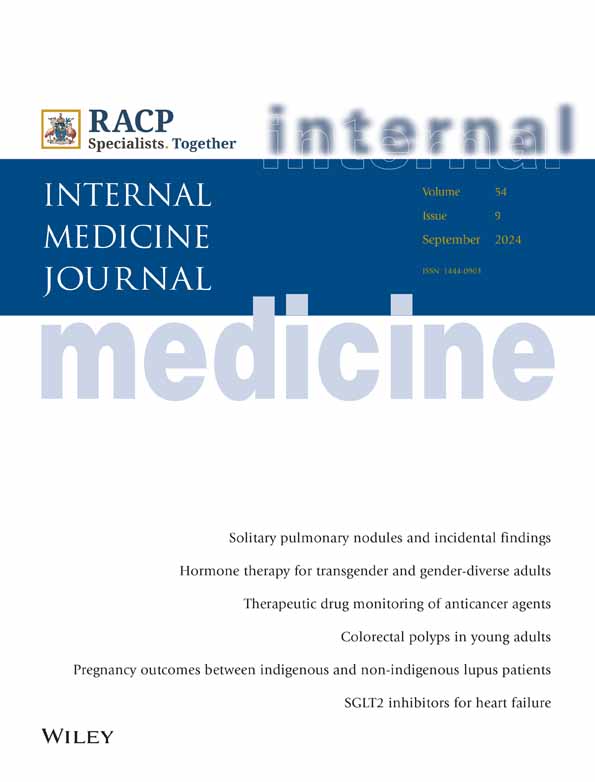Examining capillary ketone testing in hospitalised patients: indications and outcomes
Corresponding Author
Thomas Kent
Northern Health, Melbourne, Victoria, Australia
Correspondence
Thomas Kent, Northern Health, 185 Cooper Street, Melbourne, Vic. 3076, Australia.
Email: [email protected]
Search for more papers by this authorSpiros Fourlanos
Diabetes and Endocrinology, The Royal Melbourne Hospital, Melbourne, Victoria, Australia
Department of Medicine at Royal Melbourne Hospital, The University of Melbourne, Melbourne, Victoria, Australia
Australian Centre for Accelerating Diabetes Innovations, The University of Melbourne, Melbourne, Victoria, Australia
Search for more papers by this authorMervyn Kyi
Northern Health, Melbourne, Victoria, Australia
Diabetes and Endocrinology, The Royal Melbourne Hospital, Melbourne, Victoria, Australia
Department of Medicine at Royal Melbourne Hospital, The University of Melbourne, Melbourne, Victoria, Australia
Australian Centre for Accelerating Diabetes Innovations, The University of Melbourne, Melbourne, Victoria, Australia
Search for more papers by this authorCorresponding Author
Thomas Kent
Northern Health, Melbourne, Victoria, Australia
Correspondence
Thomas Kent, Northern Health, 185 Cooper Street, Melbourne, Vic. 3076, Australia.
Email: [email protected]
Search for more papers by this authorSpiros Fourlanos
Diabetes and Endocrinology, The Royal Melbourne Hospital, Melbourne, Victoria, Australia
Department of Medicine at Royal Melbourne Hospital, The University of Melbourne, Melbourne, Victoria, Australia
Australian Centre for Accelerating Diabetes Innovations, The University of Melbourne, Melbourne, Victoria, Australia
Search for more papers by this authorMervyn Kyi
Northern Health, Melbourne, Victoria, Australia
Diabetes and Endocrinology, The Royal Melbourne Hospital, Melbourne, Victoria, Australia
Department of Medicine at Royal Melbourne Hospital, The University of Melbourne, Melbourne, Victoria, Australia
Australian Centre for Accelerating Diabetes Innovations, The University of Melbourne, Melbourne, Victoria, Australia
Search for more papers by this authorAbstract
Elevated blood ketone levels (ketosis) in inpatients with diabetes can herald diabetic ketoacidosis (DKA). However, ketosis can also occur in individuals without diabetes in certain settings. It is unclear what proportion of inpatients with ketosis are in DKA and which patients are at the highest risk of DKA. This study determined that many ketone tests are performed in individuals at low risk of DKA, and a β-hydroxybutyrate <1.0 mmol/L had a low incidence of DKA and less need for escalation in their management.
Supporting Information
| Filename | Description |
|---|---|
| imj16490-sup-0001-AppendixA.docxWord 2007 document , 32.8 KB | Appendix A. Original capillary blood ketone testing policy and quality control testing procedure. |
| imj16490-sup-0002-AppendixB.docxWord 2007 document , 29.7 KB | Appendix B. Revised capillary blood ketone testing policy. |
Please note: The publisher is not responsible for the content or functionality of any supporting information supplied by the authors. Any queries (other than missing content) should be directed to the corresponding author for the article.
References
- 1Cantrell CB, Mohiuddin SS. Biochemistry, Ketone Metabolism. StatPearls. Treasure Island (FL): StatPearls Publishing Copyright ©2023, StatPearls Publishing LLC; 2023. Available from URL: https://www.ncbi.nlm.nih.gov/books/NBK554523/
- 2Douros A, Lix LM, Fralick M, Dell'Aniello S, Shah BR, Ronksley PE et al. Sodium-glucose cotransporter-2 inhibitors and the risk for diabetic ketoacidosis: a multicenter cohort study. Ann Intern Med 2020; 173: 417–425.
- 3Palmer BF, Clegg DJ. Euglycemic ketoacidosis as a complication of SGLT2 inhibitor therapy. Clin J Am Soc Nephrol 2021; 16: 1284–1291.
- 4Brewster S, Curtis L, Poole R. Urine versus blood ketones. Pract Diabetes 2017; 34: 13–15.
- 5Danne T, Garg S, Peters AL, Buse JB, Mathieu C, Pettus JH et al. International consensus on risk management of diabetic ketoacidosis in patients with type 1 diabetes treated with sodium-glucose cotransporter (SGLT) inhibitors. Diabetes Care 2019; 42: 1147–1154.
- 6Burstal RJ, Reilly JR, Burstal B. Fasting or starving? Measurement of blood ketone levels in 100 fasted elective and emergency adult surgical patients at an Australian tertiary hospital. Anaesth Intensive Care 2018; 46: 463–467.
- 7Meyer EJ, Mignone E, Hade A, Thiruvenkatarajan V, Bryant RV, Jesudason D. Periprocedural euglycemic diabetic ketoacidosis associated with sodium-glucose cotransporter 2 inhibitor therapy during colonoscopy. Diabetes Care 2020; 43: e181–e184.
- 8 Australian Diabetes Society. ALERT UPDATE May 2023: Periprocedural Diabetic Ketoacidosis (DKA) With SGLT2 Inhibitor Use In People With Diabetes. 2023. Available from URL: https://www.diabetessociety.com.au/wp-content/uploads/2023/05/ADS-ADEA-ANZCA-NZSSD_DKA_SGLT2i_Alert_Ver-May-2023.pdf
- 9Hamblin PS, Wong R, Ekinci EI, Sztal-Mazer S, Balachandran S, Frydman A et al. Capillary ketone concentrations at the time of colonoscopy: a cross-sectional study with implications for SGLT2 inhibitor–treated type 2 diabetes. Diabetes Care 2021; 44: e124–e126.
- 10Kalsi M, Farzanehfar P, Robins M, Varadarajan S, Kyi M. Hospital-wide audit detects high prevalence of diabetes-related medication errors and clinical inertia. Int J Sci Res 2022; 11: 27–28.
- 11Thiruvenkatarajan V, Meyer EJ, Jesudason D. Comment on Hamblin et al. Capillary ketone concentrations at the time of colonoscopy: a cross-sectional study with implications for SGLT2 inhibitor–treated type 2 diabetes. Diabetes Care 2021;44:e124–e126. Diabetes Care 2021; 45: e15–e16.
10.2337/dc21-1413 Google Scholar
- 12Hamblin PS, Wong R, Ekinci EI, Sztal-Mazer S, Balachandran S, Frydman A et al. Response to Comment on Hamblin et al. Capillary ketone concentrations at the time of colonoscopy: a cross-sectional study with implications for SGLT2 inhibitor–treated type 2 diabetes. Diabetes Care 2021;44:e124–e126. Diabetes Care 2021; 45: e17–e18.
10.2337/dci21-0048 Google Scholar
- 13Bach LA, Ekinci EI, Engler D, Gilfillan C, Hamblin PS, MacIsaac RJ et al. The high burden of inpatient diabetes mellitus: the Melbourne public hospitals diabetes inpatient audit. Med J Aust 2014; 201: 334–338.
- 14Wang R, Colman PG, Kyi M, Russell N, Fourlanos S. Longitudinal prevalence of inpatient diabetes mellitus in an Australian hospital across five decades: 1972–2019. Intern Med J 2021; 51: 814–815.
- 15Donovan P, Eccles-Smith J, Hinton N, Cutmore C, Porter K, Abel J et al. The Queensland Inpatient Diabetes Survey (QuIDS) 2019: the bedside audit of practice. Med J Aust 2021; 215: 119–124.
- 16 NSW Agency for Clinical Innovation. Use of SGLT2-Inhibitors for Type 2 Diabetes in Acute Inpatient Care: Clinical Practice Guide. Sydney: ACI; 2023. Available from URL: https://aci.health.nsw.gov.au/__data/assets/pdf_file/0010/825085/ACI-Use-of-SGLT2-inhibitor-medicines-for-people-with-diabetes.pdf




